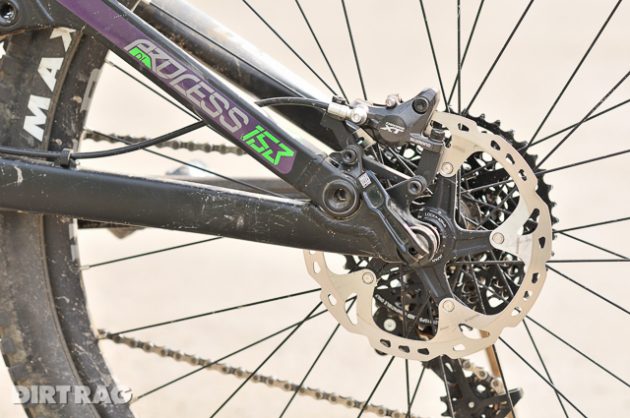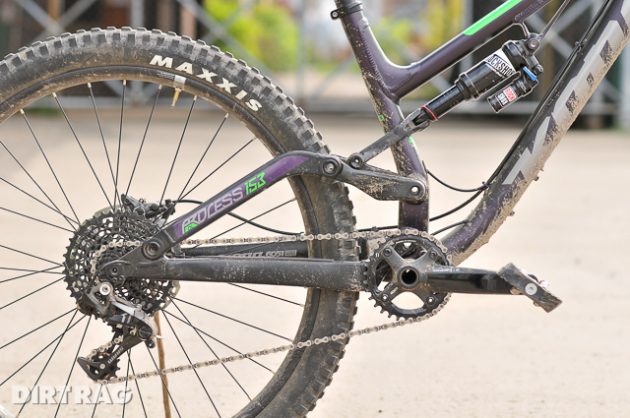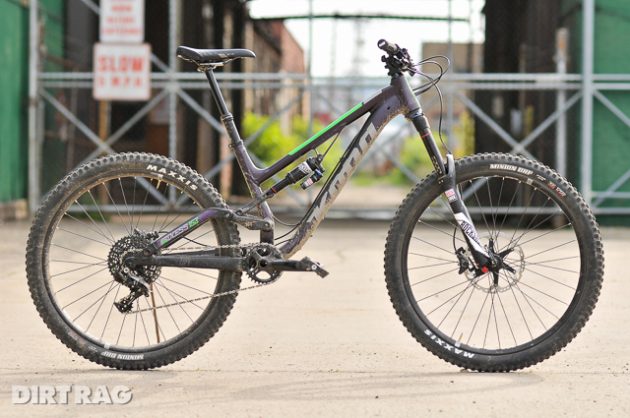Review: Kona Process 153
Originally posted on August 23, 2016 at 7:00 amTester: Justin Steiner
Age: 33, Height: 5’7″, Weight: 165 lbs., Inseam: 31”
Bike price: $5,000
Sizes: M, (tested) L, XL
Kona first launched the Process lineup in 2013 for the 2014 model year. Since then, we’ve reviewed and revered both the 29 inch Process 111 (issue #178) and the 27.5 inch Process 134 (issue #184). Based on those positive experiences, I was stoked to see what the Process 153 has to offer.
Where the Process 111 and 134 target the trail category, the 153 presents a burlier option for riders on the enduro and all-mountain end of the spectrum. Suspension travel is 153 mm at the rear wheel, damped by a Monarch Plus RC3. A 160 mm RockShox Pike holds down the fort up front.

When the Process bikes were announced, they were on the bleeding edge of the longer, lower and slacker new-school geometry movement we’ve seen gain traction in the years since. As geometry trends progress, the once-extreme geometry of the Process bikes now largely represents the new normal. In no way is that a bad thing though, the market has largely just caught up to the Process bikes in the three years since their introduction. That said, Kona will be subtly revising the Process’ geometry for the 2017 model year.
In this day and age of making everything out of carbon fiber, the Process bikes represent a bit of an outlier in terms of their aluminum construction. Though this move doesn’t necessarily make for a terribly light bike, I’m always impressed by how well aluminum bikes, particularly those with aluminum rims, communicate what’s happening at the tires’ contact patches. I’m not 100 percent certain why that is, but here’s my theory: Without the inherent vibration damping qualities of carbon, the sensory connection simply feels more direct.

As you might expect, this DL model checks the proper boxes with solid parts spec all around. The SRAM X1/X01 drivetrain provides reliable locomotion and ample gearing range for most situations. In mountain country, I’d likely drop down from the 32-tooth chainring to a 30-tooth ‘ring to provide a slightly easier gearing range.
For years, Shimano brakes represented the gold standard in terms of reliable braking, but the latest generation XT and XTR brakes have been a little bit of a hiccup for the company. We have word that Shimano has recently fixed the issues once and for all, but the brakes on this bike exhibit the migrating engagement point that we’ve noted on a handful of brake sets. This, however, should not be an issue on future Process models.
The KS Lev Integra dropper post operated flawlessly through the test period, and I really dig the ergonomics of the company’s Southpaw remote. The other notable parts spec is WTB’s new Asym i35 rims front and rear. These wide (35 mm internal width) rims provided an awesomely stable platform for the 2.3 inch Minion DHF tires. The rim’s asymmetrical design also goes a long way toward equalizing spoke tension.

Speaking of wheels, it’s worth noting that the Process line was launched before 148 mm hub spacing was anything more than a twinkle in an engineer’s eye. So no 148 mm spacing or plus tire compatibility here.
The 153’s head tube angle clocks in at 66.5 degrees, the bottom bracket sits 13.4 inches off the deck and the wheelbase measures a rangy 45.7 inches, despite short 16.7 inch chainstays. The resulting 29 inch front center measurement provides a lot of stability at speed and in steep terrain. The steep-ish 74 degree seat tube angle and long top tube yield a 17.1 inch reach on my medium test bike, which provides a weight forward climbing position that helps to keep the front wheel down and tracking up hill.
Even though my maiden voyage aboard the Process occurred on unfamiliar trails, I was immediately comfortable on the bike, and it quickly encouraged exploring the limits. Like most bikes in this category, the Process is a very capable machine. The long front center provides stability that belies the 66.5 degree headtube angle, making it feel as though it were slacker, but without the slow-speed wheel fl op that comes along with slacker angles. The front end stability is nicely balanced by the responsiveness of the short chainstays, which whip nicely around corners and greatly ease lofting the front wheel.

The Process’ suspension performance was impressive. The rear suspension is stable and well-damped under pedaling forces, but remains responsive to small bumps while pedaling. Pointed down hill that same sense of chassis stability remains, but small and large bumps are dispatched with equal aptitude.
As you’d expect from the folks at Kona, the Process also handles big hits without breaking a sweat. The spring rate ramps up nicely to fend off bottom out without the rider even noticing. The travel o-ring indicated that I had used full travel, but I never felt a noticeable bottom out.

Regardless of the type of trails I was riding, the Process felt balanced and composed in all situations, from fast and rowdy descents in Pisgah National Forest to smooth and flowing trails in central Michigan. It never felt like overkill on the trail or left me wanting more capability. Sure, it may be overkill for tame trails, but even in those settings, the Process encourages you to hit the optional lines. When the going gets rowdy, the Process 153 really shines.
All in all, the Process 153 offers an impressive balance of capability and versatility. Whether it is your only bike, or the enduro bike of your quiver, it makes a compelling case for itself.
Kona Process 153 Details
- Reach: 17.1”
- Stack: 23.5”
- Top Tube: 23.7”
- Head Tube: 66.5°
- Seat Tube: 74°
- BB Height: 13.4”
- Chainstays: 16.7”
- Wheelbase: 45.7”
- Weight: 30.0 lbs. (with 29” wheels) w/o pedals
- Specs based on size tested
- More info: Kona Process lineup
